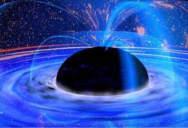New Study Shows That Primordial Black Holes Were Much Less Common Than Previously Thought

For many scientists, dark matter is a very important part of the universe, and one that they have yet to prove even exists.
This type of matter is necessary for making the math with a variety of other key theories to work correctly.
With this in mind, many people are working at coming up with theories that would give more information about dark matter, how it was formed, and where it is.
One of the most popular theories is that dark matter is ‘hiding’ in black holes that are believed to exist near the very beginning of the universe itself.
These primordial black holes are not massive like the ones seen today, but instead are microscopic. Some believe they are only the size of an atom.

With their size being so small, the theory suggest that there would be a huge number of them throughout the early universe.
There is just one problem with that.
None have been found when looking at the cosmic microwave background (CMB), which is the remnants of the light from these early times.
Two new studies have been published that suggest that these primordial black holes may actually have been far rarer than previously thought.
Jason Kristiano, one of the coauthors of the studies, commented about this idea in a statement:
“Many researchers feel they are a strong candidate for dark matter, but there would need to be plenty of them to satisfy that theory. But despite strong reasons for their abundance, we have not seen any directly, and now we have a model which should explain why this is the case.”
The research suggests that the primordial black holes may have been created due to gravitational waves that are short but strong collapsing into themselves.
These waves may not have been as common as previously thought.
Jun’ichi Yokoyama, another coauthor of the studies from the University of Tokyo’s Kavli Institute for the Physics and Mathematics of the Universe said:
“What we have found is that these tiny but strong waves can translate to otherwise inexplicable amplification of much longer waves we see in the present CMB. While individual short waves would be relatively powerless, coherent groups would have the power to reshape waves much larger than themselves.”
Of course, this is still just a theory, but it does a good job of not only explaining why we have not seen the primordial black holes in the CMB, but also allowing theories based on dark matter to continue to work.
The hope is that someday there will be gravitational wave observatories in space, which will allow researchers to be more certain in these answers.
For now, scientists will continue to put forth theories attempting to explain our universe.
If you thought that was interesting, you might like to read about a quantum computer simulation that has “reversed time” and physics may never be the same.

Sign up to get our BEST stories of the week straight to your inbox.




